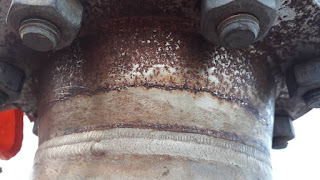Thank you so much raghutam for your valuable information.
But the MAPAF department says they didn't find any crack during erection ( no images during the erection period).
Even I requested to go PMI test. Since the pipe material is A312 TP 316L and nozzle flange A182 TP 304L.
Since the connected equipment is deareator the vessel already tested at shop and the connected pipes are tested seperatly long back ( not with the equipment) and after blowing connected to the respective equipment.
Are you agreed the material of the nozzle is SS ar per the site photo I attached. I suspect it is not SS.i need to add one more point that the vessel is A516bgr 70 and the nozzle is SS do you feel any possibility of this problem is due to dissimilar welding. Pls share your opinions
Thanks and regards
On Thu, 17 Oct, 2019, 4:44 AM Raghuram Bathula, <raghurambathula@gmail.com> wrote:
--i have experienced such failures in the past on a high alloy material probably occurred during piercing operations in the forging process. Piercing operations generallyproduce relatively high tensile and shear deformation in the material at the weld neck portion of the flange, typically due to inadequate working temperature during piercing operation, can result in cracking.is it hydro tested? these may not be visible while receipt inspection, will start propagating after welding, hydro etc.did you confirm the grade of SS with PMI? do extend cross check with PT on similar heat/ same supplierOn Thu, 17 Oct 2019 at 08:58, Chiranjeevi A <chiranjeevipuvvula@gmail.com> wrote:Dear All,Please find the attached snap, we found a crack circumferentially. The nozzle size is 6" and the material is SS.The following plant is under construction and the vessel erected around 1yr back. There is an argument that because of pipe loads that are not supported yet, it created tension and lead to crack. Even I surprised that how a steel material started cracked like brittle for just for a few external loads. (This not the correct reason)I clearly explained that any steel material that we design to be below the yield value. When the load beyond the ultimate limit it leads to fatigue and finally crack. This situation we can expect in operation if there is cyclic loading and the connected piping not supported properly. (which is an impossible situation).Finally, I suspect that- the material of the nozzle is not SS. (Maybe zinc coated)- (or) Because of corrosion-(or) during welding, it created a weaker section and started crack initiation for the external loads.Experts kindly share your opinion and suggestions.Thanks & Regards
https://materials-welding.blogspot.com/
https://www.linkedin.com/groups/122787
---
You received this message because you are subscribed to the Google Groups "Materials & Welding" group.
To unsubscribe from this group and stop receiving emails from it, send an email to materials-welding+unsubscribe@googlegroups.com.
To view this discussion on the web visit https://groups.google.com/d/msgid/materials-welding/CADxVubm1EOGoLHCV7n9NykiDGayf%2Bg%2B83guy6a%3Dbr4fXAArAzg%40mail.gmail.com.
https://materials-welding.blogspot.com/
https://www.linkedin.com/groups/122787
---
You received this message because you are subscribed to the Google Groups "Materials & Welding" group.
To unsubscribe from this group and stop receiving emails from it, send an email to materials-welding+unsubscribe@googlegroups.com.
To view this discussion on the web visit https://groups.google.com/d/msgid/materials-welding/CAN4%2Bm0xjSytzk%3DED8K6ocMqZ5bmnTLKnDhynvS%2BbuQBj_NDE9g%40mail.gmail.com.


Comments